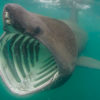Phoronids are a group of exclusively marine animals that most people have never heard of, let alone seen. They are classified, logically, in the Phylum Phoronida. All are long and skinny, small (usually less than a foot long), and live in tubes of their own making. They superficially resemble annelid worms, particularly feather duster worms, but they don’t have the true tentacles or the segmented of worms. Rather, their mouths are surrounded by a structure called a “lophophore.” Thus they are allied with brachiopods (which again, few people have heard of) and the more familiar bryozoas.
There are only about one dozen species of phoronids throughout the world. They inhabit temperate and tropical seas, mainly in shallow water, but some range down to about 1,200 feet. They display some variation in shape and features depending upon habitat and location, making exact classification of them quite challenging.
To add to the confusion, when phoronids reproduce, their larvae are so different from the adults that scientists at first thought they were totally unrelated creatures. These larvae, called “artinotrochs” are typically formed through hermaphroditic reproduction, although with some species, the sexes are separate.
About two to three weeks after being released into the plankton, these artinotrochs metamorphosize—and in a hurry! In less than 30 minutes— wham!—a young phoronid is formed.
That metamorphosis changes the internal structure of the phonorids so that their mouths and anuses become very close to each other—an ideal arrangement for a tube dwelling animal. The juveniles settle on appropriate habitats (usually soft mud or sand, but in some species, on pier pilings or seashells). Then they form their tubes from bits of their surrounding environment, and get on with the business of filtering food with their lophophores.
All of this information is the kind of stuff that up-and-coming biologists struggle with in the classroom. Interesting, yes, but hard to find too relevant when there is little chance of meeting a phoronid “in person.”
Ah, but here is where California divers have all the advantages. They have not only the remote chance, but there is a strong likelihood that they will come into close contact with phoronids. And not just a few, stray, rare individuals, but hundreds, thousands, even tens of thousands of them.
In the calm bays and estuaries of Central California north to Oregon, the Green Phoronid (Phoronipsis viridis) forms dense beds, with as many as 1,000 animals per square yard. Nothing even close to this occurs anywhere else in the world. These phoronids have bodies that are a reddish-brown due to the presence of real hemoglobin in their blood, but what is visible to divers is a soft, swaying “grassy field” of expanded greenish lophophores.
Southern California divers don’t need to feel left out of the phoronid scene however. The Golden State, from Point Conception to Newport Bay, offers an abundance of the golden lophophores of the California Phoronid (P. californica). Although these don’t form true beds like the more northern species, they can be found in rich concentrations as well.
Altogether, there are about eight California phoronid species—an impressive representative in itself for a phylum that only has about a dozen species total. And certainly the beauty of all of these is enhanced when a diver realizes that anywhere else on earth, an encounter with any sort of phoronid is an extreme rarity. That in itself is enough to make a person want to start a phoronid photo album. But be careful about photographing these little critters with their showy lophophores. Disturb them too much, and they will also show off how their giant nerve cells, which run the entire length of their bodies, give them the ability to instantaneously retract themselves back into their tubes.










